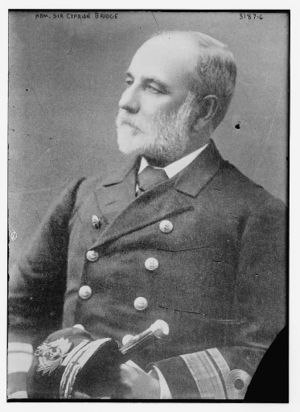Cyprian Arthur George Bridge: Difference between revisions
mNo edit summary |
Simon Harley (talk | contribs) |
||
| Line 37: | Line 37: | ||
{{TabAppts}} | {{TabAppts}} | ||
{{Appt | |||
|[[Naval Intelligence Department (Royal Navy)|Director of Naval Intelligence]]|[[William Henry Hall|William H. Hall]]|1889 – 1894|[[Lewis Anthony Beaumont|Lewis A. Beaumont]] | |||
}} | |||
{{Appt | |||
|[[Australian Station|Commander-in-Chief on the Australian Station]]|[[Nathaniel Bowden-Smith]]|1894 – 1897|[[Hugo Lewis Pearson|Hugo L. Pearson]] | |||
}} | |||
{{Appt | {{Appt | ||
|[[China Station|Commander-in-Chief on the China Station]]|[[Edward Hobart Seymour|Sir Edward H. Seymour]]|1901 – 1904|[[Gerard Henry Uctred Noel|Sir Gerard H. U. Noel]] | |[[China Station|Commander-in-Chief on the China Station]]|[[Edward Hobart Seymour|Sir Edward H. Seymour]]|1901 – 1904|[[Gerard Henry Uctred Noel|Sir Gerard H. U. Noel]] | ||
Revision as of 01:25, 8 November 2012
Admiral SIR Cyprian Arthur George Bridge, G.C.B., Royal Navy (13 March, 1839 – 16 August, 1924) was an officer of the Royal Navy.
Early Life & Career
Bridge was promoted to the rank of Rear-Admiral on 25 February, 1892, vice Nicholson.[1]
Bridge was promoted to the rank of Vice-Admiral on 29 November, 1898, vice Tracey.[2]
On the occasion of the Queen's birthday he was appointed an Ordinary Member of the Second Class, or Knight Commander, in the Military Division of the Most Honourable Order of the Bath (K.C.B.) on 3 June, 1899.[3]
As part of a running correspondence kept up with the Admiralty, Bridge wrote the following complaint to the First Sea Lord, Lord Walter Kerr regarding the ships in reserve at Hong Kong:
The "SWIFT", "ESK", "WIVERN", "FIREBRAND", "MIDGE", and all the torpedo-boats, (but two which might be used for carrying messages and for nothing else), are quite useless even for training stokers, and should be got rid of at once, the officers and men now wasting their time in looking after them being employed elsewhere. If these craft cannot be sold quickly, the Commander-in-chief should be ordered to take them out into deep water and sink them. Keeping caretakers in them till their fittings could be sold would cost more than the fittings would fetch.[4]
Bridge's advocation of the sale or destruction of obsolete ships demonstrates that Sir John Fisher was not the only figure in the fin de siècle Royal Navy desirous of sacrificing obsolete ships in reserve to free manpower for more modern men-of-war.
Bridge was promoted to the rank of Admiral on 30 August, 1903, vice Hotham.[5] On the occasion of the King's birthday, Bridge was appointed an Ordinary Member of the First Class, or Knight Grand Cross, in the Military Division of the Order of the Bath (G.C.B.) on 9 November.[6]
In accordance with the provisions of the Order in Council of 22 February, 1870, he was placed on the Retired List on 15 March, 1904.[7]
Footnotes
- ↑ The London Gazette: no. 26263. p. 1201. 1 March, 1892.
- ↑ The London Gazette: no. 27029. p. 7818. 2 December, 1898.
- ↑ The London Gazette: no. 27086. p. 3585. 3 June, 1899.
- ↑ Bridge to Kerr, 5 July 1902, BRI/14, Cyprian Bridge MSS, Caird Library, National Maritime Museum.
- ↑ The London Gazette: no. 27593. p. 5476. 1 September, 1903.
- ↑ The London Gazette: (Supplement) no. 27613. p. 6851. 9 November, 1903.
- ↑ The London Gazette: (Supplement) no. 27659. p. 1791. 18 March, 1904.
Bibliography
- "Admiral Sir C. Bridge" (Obituaries). The Times. Monday, 18 August, 1924. Issue 43733, col C, p. 12.
- Bridge, Admiral Sir Cyprian, G.C.B. (1918). Some Recollections. London: John Murray.
Service Records
- The National Archives. ADM 196/70.
- The National Archives. ADM 196/36.
- The National Archives. ADM 196/14.
| Naval Appointments | ||
| Preceded by William H. Hall |
Director of Naval Intelligence 1889 – 1894 |
Succeeded by Lewis A. Beaumont
|
| Preceded by Nathaniel Bowden-Smith |
Commander-in-Chief on the Australian Station 1894 – 1897 |
Succeeded by Hugo L. Pearson
|
| Preceded by Sir Edward H. Seymour |
Commander-in-Chief on the China Station 1901 – 1904 |
Succeeded by Sir Gerard H. U. Noel
|
